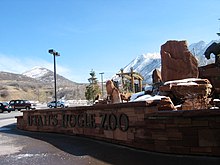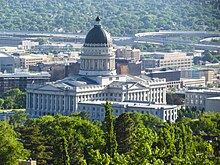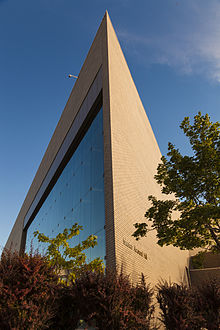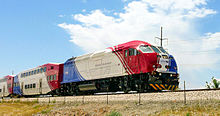
Salt Lake City, often shortened to Salt Lake or SLC, is the capital and most populous city of the U.S. state of Utah. It is the county seat of Salt Lake County, the most populous county in the state. The city is the core of the Salt Lake City Metropolitan Statistical Area (MSA), which had a population of 1,257,936 at the 2020 census. Salt Lake City is further situated within a larger metropolis known as the Salt Lake City–Ogden–Provo Combined Statistical Area, a corridor of contiguous urban and suburban development stretched along a 120-mile (190 km) segment of the Wasatch Front, comprising a population of 2,746,164, making it the 22nd largest in the nation. With a population of 200,133 in 2020, it is the 117th most populous city in the United States. It is also the central core of the larger of only two major urban areas located within the Great Basin.
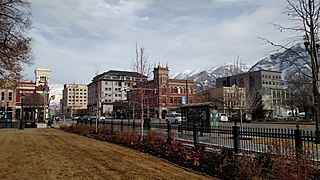
Provo is a city in and the county seat of Utah County, Utah, United States. It is 43 miles (69 km) south of Salt Lake City along the Wasatch Front, and lies between the cities of Orem to the north and Springville to the south. With a population at the 2020 census of 115,162, Provo is the fourth-largest city in Utah and the principal city in the Provo-Orem metropolitan area, which had a population of 526,810 at the 2010 census. It is Utah's second-largest metropolitan area after Salt Lake City.

Brigham City is a city in Box Elder County, Utah, United States. The population was 19,650 at the 2020 census, up from the 2010 figure of 17,899. It is the county seat of Box Elder County. It lies on the western slope of the Wellsville Mountains, a branch of the Wasatch Range at the western terminus of Box Elder Canyon. It is near the former headquarters of ATK Thiokol, now Northrop Grumman, the company that created the solid rocket boosters for the Space Shuttle.

The Territory of Utah was an organized incorporated territory of the United States that existed from September 9, 1850, until January 4, 1896, when the final extent of the territory was admitted to the Union as the State of Utah, the 45th state. At its creation, the Territory of Utah included all of the present-day State of Utah, most of the current state of Nevada save for a portion of Southern Nevada, much of modern western Colorado, and the extreme southwest corner of present-day Wyoming.

Temple Square is a 10-acre (4.0 ha) complex, owned by the Church of Jesus Christ of Latter-day Saints, in the center of Salt Lake City, Utah. The usage of the name has gradually changed to include several other church facilities that are immediately adjacent to Temple Square. Contained within Temple Square are the Salt Lake Temple, Salt Lake Tabernacle, Salt Lake Assembly Hall, the Seagull Monument, and two visitors' centers. The square was designated a National Historic Landmark District in 1964, recognizing the Mormon achievement in the settlement of Utah.

The Salt Lake City Council Hall is currently home to offices of the Utah Office of Tourism and the Utah Film Commission and is located on Capitol Hill in Salt Lake City, Utah. Built in 1864–66, the building is historically important as the Old Salt Lake City Hall or just Old City Hall from 1866 to 1894. It was designated a National Historic Landmark in 1975, as an emblem of the conflicts between the governments of the Utah Territory and the United States in the 19th century.

Capitol Hill in Salt Lake City gets its name from the Utah State Capitol prominently overlooking downtown, it is a neighborhood in Salt Lake City.

The Alfred McCune Home is one of the mansions on Capitol Hill in Salt Lake City, Utah, from around the turn of the 20th century. Built for Alfred W. McCune on the inclined south side of Capitol Hill at the northeast corner of 200 North Main Street, the mansion has 21 rooms and is on the National Register of Historic Places.

Originally, the Salt Lake Valley was inhabited by the Shoshone, Paiute, Goshute and Ute Native American tribes. At the time of the founding of Salt Lake City the valley was within the territory of the Northwestern Shoshone, who had their seasonal camps along streams within the valley and in adjacent valleys. One of the local Shoshone tribes, the Western Goshute tribe, referred to the Great Salt Lake as Pi'a-pa, meaning "big water", or Ti'tsa-pa, meaning "bad water". The land was treated by the United States as public domain; no aboriginal title by the Northwestern Shoshone was ever recognized by the United States or extinguished by treaty with the United States. Father Silvestre Vélez de Escalante, a Spanish Franciscan missionary is considered the first European explorer in the area in 1776, but only came as far north as Utah valley (Provo), some 60 miles south of the Salt Lake City area. The first US visitor to see the Salt Lake area was Jim Bridger in 1824. U.S. Army officer John C. Frémont surveyed the Great Salt Lake and the Salt Lake Valley in 1843 and 1845. The Donner Party, a group of ill-fated pioneers, traveled through the Great Salt Lake Valley a year before the Mormon pioneers. This group had spent weeks traversing difficult terrain and brush, cutting a road through the Wasatch Mountains, coming through Emigration canyon into the Salt Lake Valley on August 12, 1846. This same path would be used by the vanguard company of Mormon pioneers, and for many years after that by those following them to Salt Lake.

Downtown is the oldest district in Salt Lake City, Utah, United States. The grid from which the entire city is laid out originates at Temple Square, the location of the Salt Lake Temple.

The Beehive House was one of the official residences of Brigham Young, the second President of the Church of Jesus Christ of Latter-day Saints, in Salt Lake City, Utah, United States. The Beehive House gets its name from the beehive sculpture atop the house.

Thomas Kearns was an American mining, banking, railroad, and newspaper magnate. He was a US Senator from Utah from 1901 to 1905. Unlike the predominantly Mormon constituents of his state, Senator Kearns was Catholic.

The Brigham Young Complex is a collection of buildings historically associated with the second President and leader of the LDS Church Brigham Young, on East South Temple in the center of Salt Lake City, Utah.
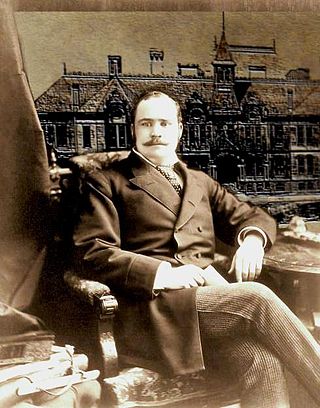
Joseph Don Carlos Young was an American architect and the Church Architect for the Church of Jesus Christ of Latter-day Saints from 1887 until 1893. In 1893, the office of Church Architect was dissolved, Young thereafter practiced privately with the LDS Church as a frequent client. Young practiced as an architect, landscape architect and designer from 1879 to circa 1935. A preponderance of his work centered on church commissions, or commissions offered him by extended Young family members, or higher echelon church friends.

Avard Tennyson Fairbanks was a 20th-century American sculptor. Over his eighty-year career, he sculpted over 100 public monuments and hundreds of artworks. Fairbanks is known for his religious-themed commissions for the Church of Jesus Christ of Latter-day Saints including the Three Witnesses, Tragedy of Winter Quarters, and several Angel Moroni sculptures on spires of the church's temples. Additionally, Fairbanks sculpted over a dozen Abraham Lincoln-themed sculptures and busts among which the most well-known reside in the U.S. Supreme Court Building and Ford's Theatre Museum.

The Brigham Young Winter Home and Office is a historic house museum located in St. George, Utah. The home and office once belonged to Brigham Young, the foremost Mormon pioneer and second president of the Church of Jesus Christ of Latter-day Saints. During Young's later years, his arthritis precluded him from spending winters in the Salt Lake City region, so a winter home in St. George—located in the arid Dixie region of the state—was acquired. He seasonally occupied the property from 1873 to 1877.

The Council House, often called the State House, was the first public building in Utah; being constructed in 1849–50. The building stood in Salt Lake City, Utah Territory, on the corner of Main Street and South Temple Street. On June 21, 1883 the building was destroyed when a neighboring wagon depot caught fire and several barrels of gunpowder exploded, spreading the fire to the Council House.
Lorenzo Snow Young, nicknamed "Bing", was a 20th-century architect in Utah. Young practiced for 40 years in Salt Lake City, Utah and is credited with having designed over 700 buildings.

The following outline is provided as an overview of and a topical guide to the Church of Jesus Christ of Latter-day Saints.
Peter M. Fillerup was an American sculptor. A member of the Church of Jesus Christ of Latter-day Saints, he attended Brigham Young University–Idaho and Brigham Young University in Provo. He was trained by Utah sculptor Avard Fairbanks. He designed a sculpture of Porter Rockwell, who served on the Council of Fifty, as well as lighting fixtures for 20 LDS temples, including the Payson Utah Temple and the Lima Peru Temple. In 1997, he designed the Hilda Erickson Memorial Statue, a public statue in memory of all American pioneers in Grantsville, Utah.


